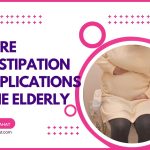Impacted Stool: Treatments & Best Laxative, A Doctor's Top Tips.
Our content is not intended nor recommended as a substitute for medical advice by your doctor. Use for informational purposes only.
Impaction of the stool occurs when a hardened stool mass is retained inside the last part of the colon or in the rectum.
In severe cases, the stool me turn into a hard stone-like mass that obstructs the sigmoid colon or the rectum.
This article will discuss the different treatments for fecal impaction and the best laxative for impacted stool.
Table of Contents
Fecal impaction can occur at two levels:
Distal stool impaction:
The impacted mass is often present in the rectum, and fingers can feel it through the anal opening.
We don’t use oral laxatives as a first-line treatment. Instead, we try to manually dis-impact the mass with the help of enemas and abdominal massage.
Using laxatives for distal stool impaction can do more harm than good. In such cases, Laxatives are ineffective and may worsen the symptoms and cause more abdominal pain, distension, and vomiting.
Proximal stool impaction:
Proximal fecal impaction is a less common variant. The impacted stool lies high in the colon (sigmoid or left descending colon).
Proximal stool impaction is challenging to diagnose. This is because it cannot be felt through the digital rectal examination (DRE).
Proximal fecal impaction is often diagnosed based on symptoms and confirmed by abdominal radiographs such as (reference):
- Abdominal computed tomography (CT).
- Abdominal X-ray (in the erect position).
With proximal impaction of the stool, Enemas and manual disimpaction can be ineffective as the mass is beyond these treatments’ access.
Instead, the best treatment is often a large dose of laxative. The best laxative for proximally impacted stool is Polyethylene Glycol (MiraLAX®).
However, Your doctor has to ensure that there are no complications (such as a perforation) or other conditions (such as intestinal obstruction) before using a laxative.
Don’t try to treat stool impaction at home.
If you suspect fecal impaction at home, call your doctor. Unfortunately, you cannot diagnose stool impaction by yourself.
Fecal impaction often affects elderly and debilitated people. Moreover, complications related to fecal impaction, such as colon perforation, are serious.
Don’t Try to treat fecal impaction at home because:
- You cannot confirm 100% that it is a fecal impaction without the help of your doctor.
- Your doctor can detect complications related to fecal impaction.
- You cannot determine the type of fecal impaction (proximal or distal).
- You cannot define the best treatment for your specific type of fecal impaction.
- Your doctor will work to define the risk factor and the cause of fecal impaction.
- Based on the risk factors and the cause of fecal impaction, Your doctor will define the next step and the long-term laxative to prevent a recurrence.
Complications must be excluded first.
Fecal impaction is primarily a disease of the elderly and debilitated people. This is because elderly and debilitated people are more prone to complications.
Before deciding the best treatment or laxative for fecal impaction, complications must be excluded first.
Complications of impacted stool can be in the form of (reference):
- Perforation of the colon or rectal wall due to the large impacted mass.
- Perforation can also occur due to the process of disimpaction and using an enema.
- Stool incontinence.
- Urine incontinence.
- System sepsis is due to perforation where the bacteria and their toxins. It is a life-threatening condition.
Your doctor is the only one to exclude complications. Trial to give laxatives or enemas with perforation can worsen the condition.
Laxative is not the first option in fecal impaction treatment unless:
Distal stool impaction is the common type. Laxatives are not the first line of treatment for distally impacted stool.
Laxatives Must NOT be used until your doctor manually disimpact. The distally impacted stool has to be fragmented and cleared using one or more of (reference):
- Fragmentation of the mass with a gloved finger.
- Administration of an enema with a stool softener. The enema is often administered with a specialized catheter that passes above the impacted mass.
- Using a specialized tool called the disimpactor to help fragment the hardened mass.
- Massaging the abdomen to help fragmentation.
- Often, a combination of two methods is used.
Once the impacted mass has cleared, Your doctor will prescribe an oral laxative to help alleviate the bowel and prevent future recurrence.
The only case when laxatives are used as first-line treatment for stool impaction is with the proximal type.
The impacted mass is often deep inside the colon with the proximal type, out of the reach of enemas and fingers.
In such a case, the best way to treat the impaction is to use a large dose of oral laxative (see the next section).
MORE: How to know fecal impaction has been cleared.
The best laxative for impacted stool and its dose.
The best laxative for proximally impacted stool is Polyethylene glycol (MiraLAX®). Moreover, it can be used long-term after clearing fecal impaction (reference).
Your doctor will give you a large dose of the laxative (about one to three liters). The dose is often given over hours (frequent small doses).
The response is often delayed for hours. No more Miralax should be given if nausea or severe abdominal pain occurs.
MiraLAX is given orally for Impacted stool only if:
- Intestinal obstruction due to structural causes or volvulus is excluded.
- Perforation is excluded.
- The impacted stool mass is proximal (the enemas and manual disimpaction are ineffective).
How to prevent the recurrence of fecal impaction.
After clearance of the fecal impaction, your doctor will work with you to prevent a recurrence. The three main strategies for preventing recurrence are:
- Defining the cause of impaction and treating it).
- Dietary modification (water and high-fiber diet.
- Long-term laxative.
Impaction occurs as a result of severe constipation. Identifications of the causes include medications, a low-fiber diet, or another factor that worsens constipation.
The best long-term laxative for impacted stool varies according to individual cases. Your doctor may prescribe MiraLAX or fiber laxatives such as Metamucil.
Ask your doctor about the best option. Fiber laxatives are preferred for long-term use as they are safer. Don’t use osmotic laxatives such as Miralax regularly unless prescribed by your doctor.
More: Miralax side effects in the elderly.
- Evidence-based
- Written by a doctor.

Related Posts:
- 7 Effective Hiatal Hernia Pain Relief Tips: Doctor Explains.
- Top 9 Mistakes That Make Your IBS in Constant Flare-Ups.
- 8 Tips To Avoid Vomiting & Nausea During Colonoscopy…
- Hiccups: Causes, Types, & Treatments.
- Metformin-Induced Diarrhea: 7 Best Treatments.
- Bloated as Pregnant? 6 Main Causes & Treatments.





